Hiking socks come in many different varieties, with each having its own benefits to offer. Some are designed for warmth and others for comfort. For those who hike often, it is important to find the perfect balance between these two qualities so that your feet don’t overheat or become too uncomfortable on the trail. Choosing hiking socks can be difficult because there are so many options available. However, this blog post will provide you with a step by step guide on how to choose the best hiking socks for your needs
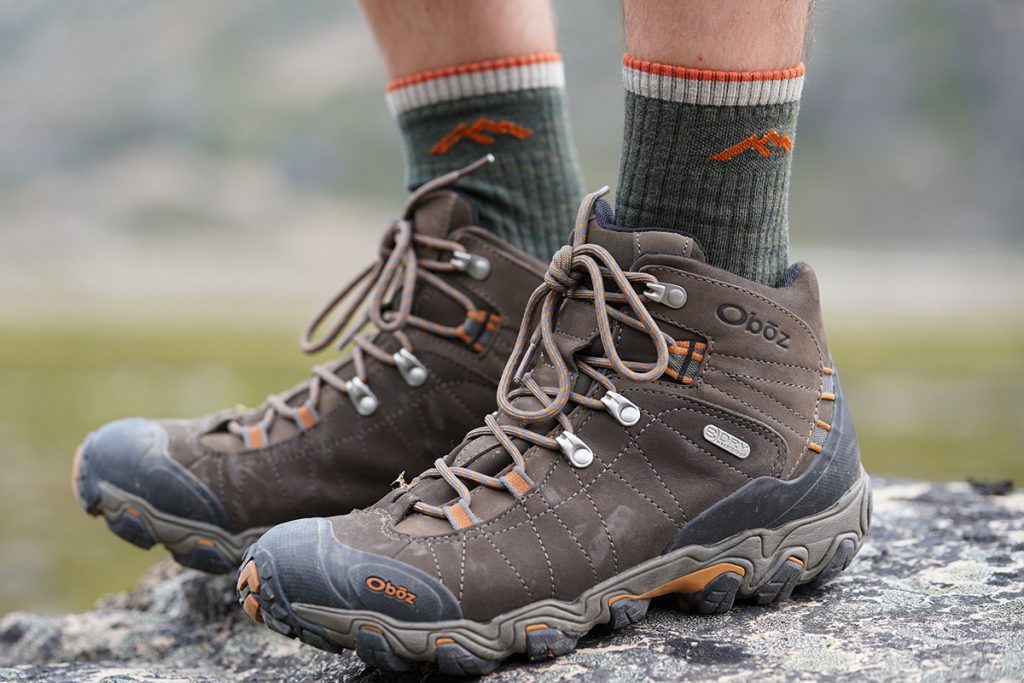
To choose the best hiking socks for your trip, it’s important to consider these four things:
- Insulation: Hiking socks should be thick enough to insulate your feet against the cold but not so thick that they make it difficult for you to feel the rocks underneath your feet as you hike. You don’t want too much insulation because this can lead to blisters from rubbing against sweaty skin or fold lines.
- Material: Hiking socks should be made of wool, polyester, or synthetic fiber that is breathable and moisture-wicking to help keep your feet dry. Wool can handle any temperature but it’s expensive and not as durable as other materials. Polyester isn’t quite as warm as wool but it also absorbs less water when wet – a huge plus. Synthetic fibers are a nice in-between of wool and polyester, but they’re more expensive than synthetics or cotton.
- Thickness: The thickness of your hiking socks depends on the conditions you will be hiking in. If you’re going to hike during summer when it’s warm out, stick with lightweight hiking socks. If you’re hiking in the winter, choose thicker socks.
- Fit: Your boots should fit well and not be too big or small. You’ll need to find a pair of socks that will fit with your boot size – check sizing charts online for this information before taking any other steps toward finding new hiking socks. Also note: if you have boots that are too big, you’ll slip around inside of them and this could lead to blisters.
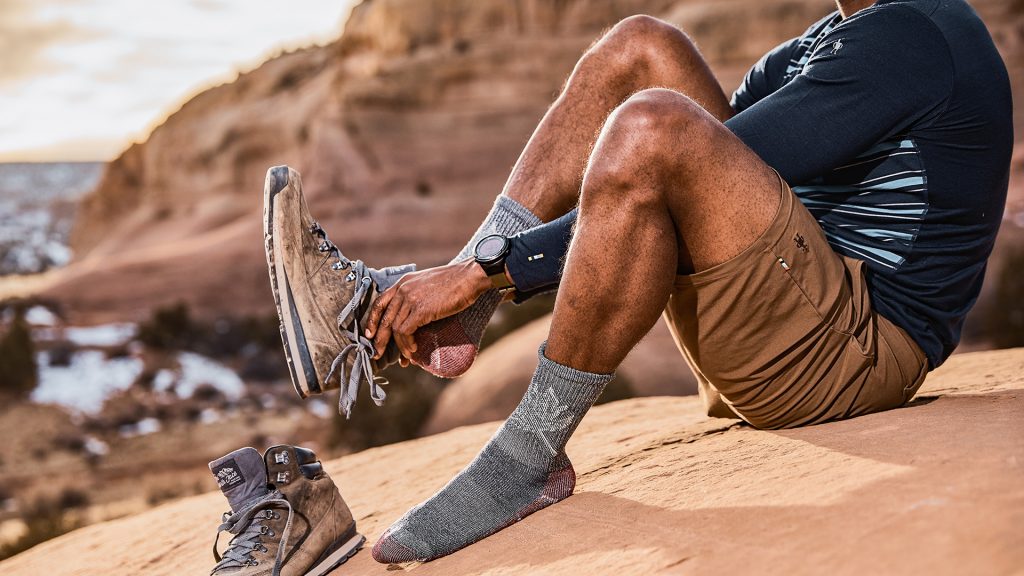
Remember: hiking socks should be thick enough to keep your feet warm but not so thick they rub against sweaty skin or fold lines. Hiking socks come in many materials – wool, polyester, and synthetic fibers all work well depending on the conditions you will be hiking in. Make sure your boots fit well with the size of your socks

Table of Contents
Hiking Sock Height
Getting the proper height of hiking socks is also important. While there are no rules about how long your boots should be, you should think about what kind of terrain you will be covering while on your hike. If you’re going to have a hard time avoiding wet or snowy conditions – say an alpine environment- then it’s best to find waterproof hiking boots that are taller. If you’re going to be hiking in a dryer area, then waterproof hiking boots aren’t necessary and mid-height or low cut boot is best for your needs.
- No-show: This sock is very short and barely covers your ankle. It’s great for low-cut shoes or sandals, but not good if it will be cold out because the lack of insulation could leave you with cold feet.
- Low: This height comes just above your ankles and keeps your lower legs warm in most conditions. They’re perfect for summertime or when hiking in a warm climate.
- Mid: This is the most common height of sock and offers medium insulation for all seasons except wintertime.
- High: These high socks come just below your knee, which keeps you very warm in cold weather but can be too hot on warmer days or hikes that take place during the summer months. They’re also a bit too warm for summer hikes.
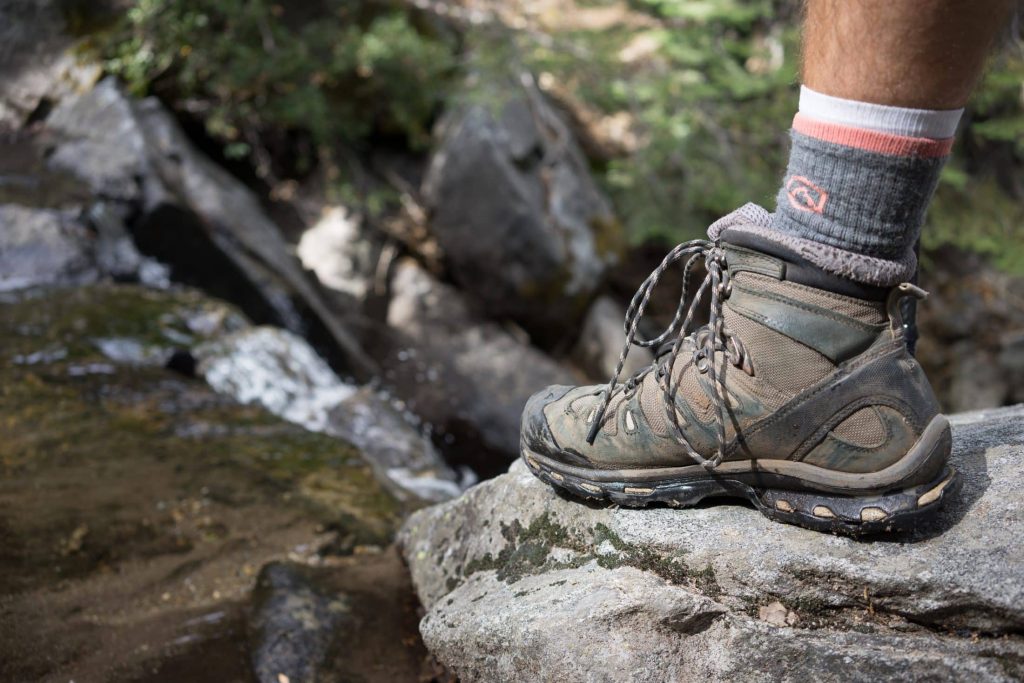
Hiking Sock Cushioning
Cushioning is what helps to protect your feet against rocks and rough terrain. It’s an important part of the sock that you should consider when deciding which one will work best for your needs.
- Blister-Proof Fabric: This type of fabric is great if you often get blisters on the backs or sides of your heels, toes, or balls of your feet.
- Moisture-Wicking Fabric: This type is great if you want to keep your feet dry and avoid blisters that are caused by sweat building up against the skin on the back of your foot. It absorbs moisture quickly so it can evaporate faster, which keeps you from having sweaty feet all day long.
- Tread: This is the fabric that goes around your toe and sometimes up to your ankle. It’s great for cold weather when you want a bit of insulation against freezing temperatures, but can be too hot during warmer months.
- No cushioning: This sock is very thin and doesn’t provide any cushioning. It’s great for warmer weather or when you’re hiking on easy terrain, but not so good if the conditions will be wet because it won’t offer any protection against rocks or rough trails.
- Cushioning: This type of sock offers a moderate amount of padding that makes it great for all seasons. It’s not too hot or too cool, making it the best choice if you hike in multiple conditions throughout spring and summertime.
- Insulation: This sock comes with a high level of insulation that works well during wintertime or when hiking in an area where temperatures tend to drop below freezing on most days. It offers maximum protection from the cold, but can be a bit too warm during other seasons or on hot days.
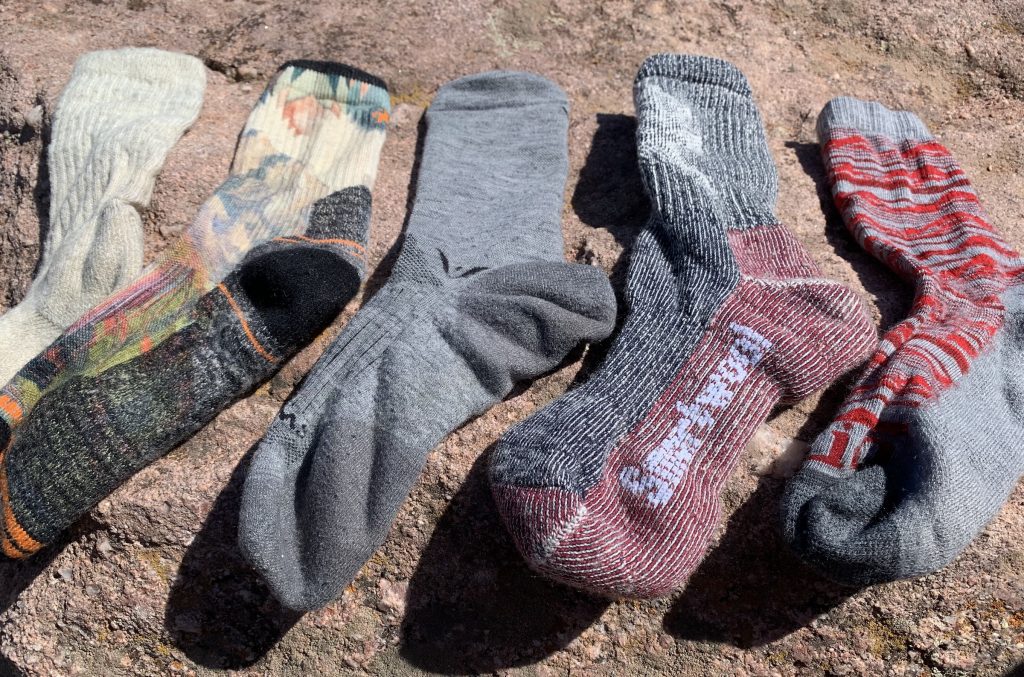
While hiking socks should be durable and sturdy enough to protect you from blisters as well as sharp rocks – You can choose to buy a pair that offers no-cushioning if you want to avoid blisters during summertime or warmer months; however, you’ll want to choose one that does offer to cushion if you plan on hiking in cold weather or during wintertime. You should also decide which height will work best for your needs and the boot type you wear before making a purchase, so keep these factors in mind when shopping around.
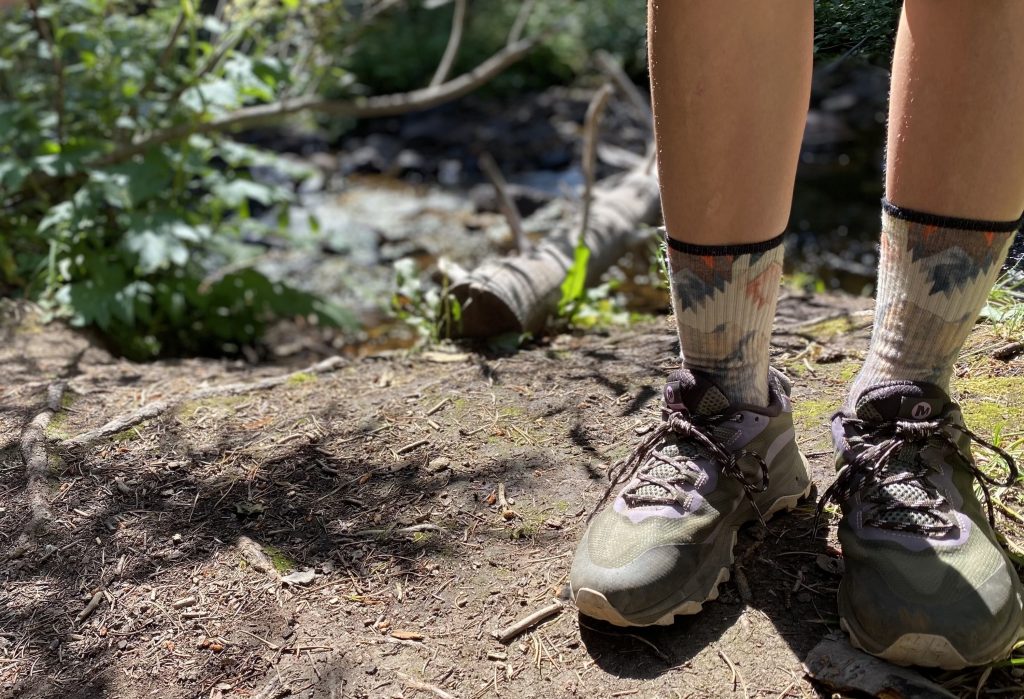
Hiking Sock Fabric Type
Most hiking socks are made from a blend of fabrics, but you will find that some are more durable than others. If durability is your top priority when buying new pairs –
You should consider purchasing those that have been reinforced with nylon or polyester at the heels and toes to ensure they stay intact for longer periods of time. Most hikers also prefer socks that have been made from a blend of wool and synthetic fabrics because they tend to wick away moisture, which helps keep your feet dry.
- Wool: This is the traditional material used for many years in socks because it’s long-lasting and offers superior insulation during cold weather or when temperatures drop below freezing on most days. It also wicks away moisture to keep your feet dry so they don’t feel sweaty and clammy.
- Synthetic: This type of sock is similar to the traditional wool one, but it’s not as warm because it doesn’t offer a high level of insulation in cold weather or when temperatures drop below freezing. It also absorbs moisture quickly so your feet won’t feel sweaty even if they get damp from rain or snow.
- Cotton: This type isn’t recommended for hiking because it absorbs moisture so quickly that your feet will be soaked through by the time you finish just one mile of walking – which can lead to blisters and chafing. It also doesn’t offer any insulation, making it feel cool in most conditions. Wool socks are a great choice if you want to avoid blisters and stay dry on the trail. They’re also a bit too warm for summer hikes, but they work well during all four seasons or in cold conditions when you need insulation against freezing temperatures. You should consider the height of socks as well as which fabric type is best suited for your needs before making a purchase because there’s a variety of options from which to choose.
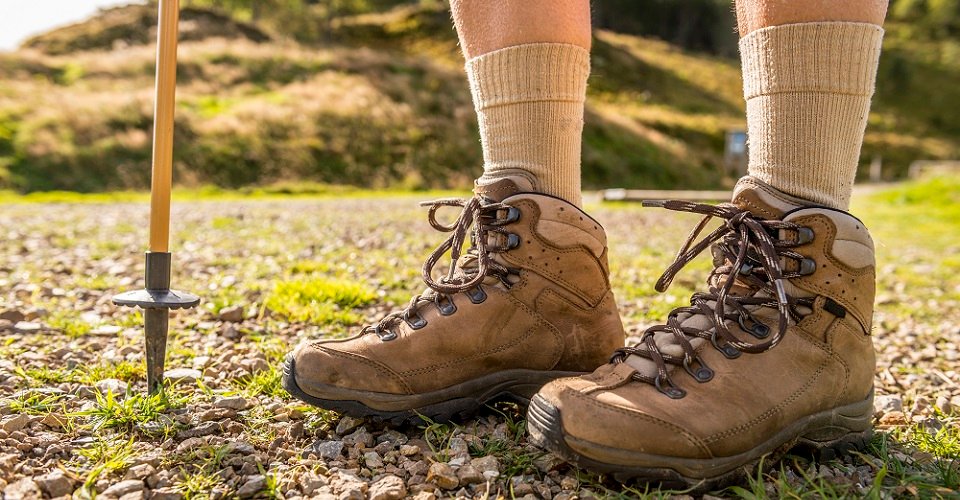
- Polyester: This material is strong and durable, which makes it a great choice if you want socks that will last for years. It’s also comfortable against the skin and doesn’t absorb moisture like cotton does, so your feet will feel dry no matter what conditions they face on the trail.
- Acrylic: This type of sock is very thin but still offers some insulation, which makes it good for winter hikes or when temperatures drop below freezing. It’s also not too warm so you can wear it during the summertime as well.
- Wicking: This fabric absorbs moisture quickly and then moves that wetness away from your skin to keep feet dry throughout a hike. However, this sock doesn’t offer much insulation so it’s not the best choice for wintertime or cold weather.
- Spandex: This material is stretchy and fits to your foot for a close fit that won’t cause blisters or chafing. It’s also thin enough to wear during summertime or on warm days when you don’t feel like adding extra layers. It does absorb moisture, but not as much as cotton does.
These are just some of the options you’ll find when shopping around for hiking socks, but there’s plenty more to choose from depending on your preferences and which fabric types you want in a sock. Wool is usually the preferred option because it keeps feet warm during all four seasons; however, some people prefer synthetic or polyester materials if they hike in warm conditions where it’s too hot for a wool sock. It all comes down to personal preference and which options will work best according to the type of hiking you plan on doing most often – whether that be during summertime heat or wintertime cold.

Hiking Sock Fit
Hiking socks are made to fit tightly against your feet, which helps prevent blisters and chafing. It also provides more warmth because the sock fits snugly around your foot so no air can get in between them – but they shouldn’t be too tight or it will feel uncomfortable while you walk. You should always try on a few pairs of socks to see which size fits best before making a purchase.
To find the sock right size for you: measure around the widest part of your foot to get the circumference. For length, measure from where the sock will sit on your leg down to the floor so it fits correctly when you wear hiking boots or shoes with a heel.
Hiking socks are usually sized according to shoe size and height; however, some brands make their own sizing system while others use the metric system. US sizes typically range from six to fifteen, but you should check with each brand for their specific sizing measurements and size chart before making a purchase
If you’re struggling to find the right fit, you can also wear thin hiking socks underneath your regular socks. This will provide extra cushioning and insulation for your feet during a hike which might make them feel more comfortable if they don’t quite fit correctly or are too tight. You should always give yourself time before starting on an outdoor adventure so you can try on your socks and make sure they fit correctly.
How socks should fit: Hiking socks should fit snugly against your foot without being too tight or too loose. They shouldn’t be so thick that they’re uncomfortable to wear either, which means you might choose a different size if the one on the pack isn’t quite right for you. If it’s difficult to find them in-store then many retailers allow customers to return socks that don’t fit
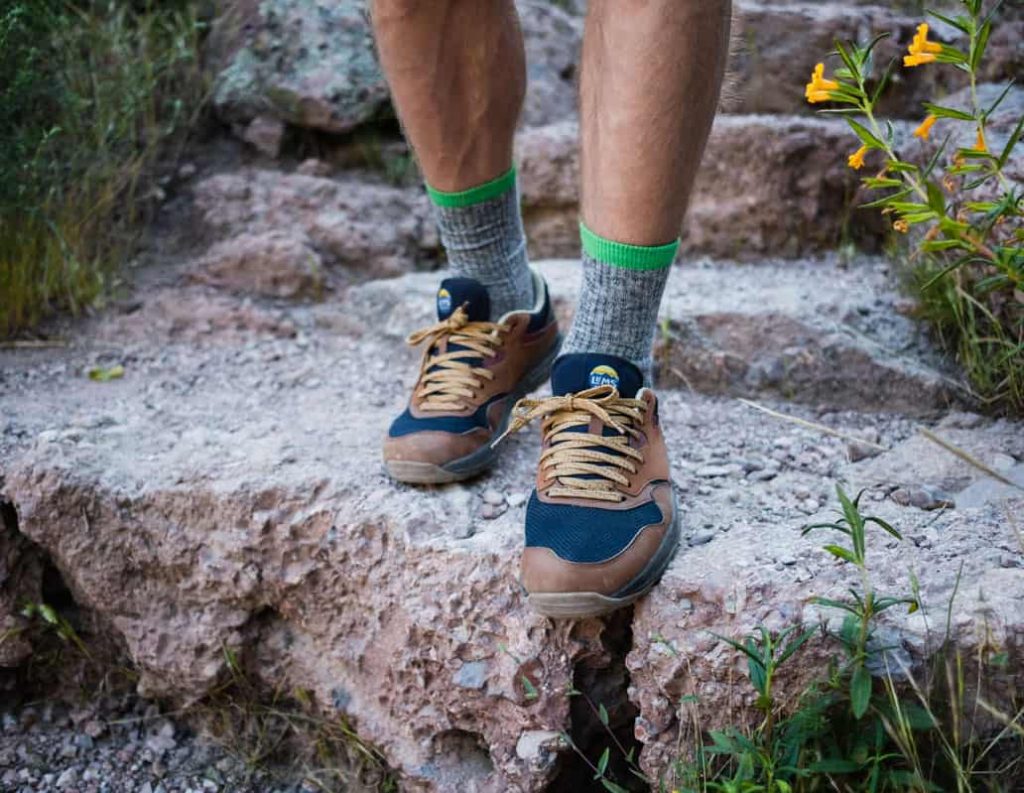
FAQ
Q.What is the best sock for hiking?
A: Wool or synthetic socks are usually considered to be ideal options, but you should try on a few pairs before deciding which one feels most comfortable. It’s also important to choose an option that has wicking properties so your feet remain dry during hikes; however, they shouldn’t feel too thin or thick and should fit correctly.
Q.How to choose hiking socks?
A: To find the right size for you, measure around your foot’s widest part using a tape measure. You can also try on different pairs of socks so you know which one feels most comfortable before making a purchase. If it’s too tight then they might cause discomfort while you walk, but if they’re too loose then the sock might fall off during your hike.
Q.Where to buy hiking socks?
A: You can find them online or in retail stores that specialize in outdoor gear and clothing; however, it’s also possible to purchase socks at general sporting goods retailers like Walmart or Dick’s Sporting Goods. You should try on socks before making a purchase so you can find the best fit for your feet.
Q.How to wash hiking socks?
A: Wash them by hand in cold water if possible. Use mild soap without bleach then rinse completely before allowing them to dry. You can also place them in the washing machine on a gentle cycle with cold water then air-dry them instead of using heat to avoid shrinkage or damage.
Q.What are the best hiking socks?
A: Wool or synthetic socks are usually considered to be ideal options, but you should try on a few pairs before deciding which one feels most comfortable. It’s also important to choose an option that has wicking properties so your feet remain dry during hikes; however, they shouldn’t feel too thin or thick and should fit correctly.
Q.How socks should fit?
Hiking socks should fit snugly against your foot without being too tight or too loose. They shouldn’t be so thick that they’re uncomfortable to wear either, which means you might choose a different size if the one on the pack isn’t quite right for you. If it’s difficult to find them in-store then many retailers allow customers to return socks that don’t fit.









